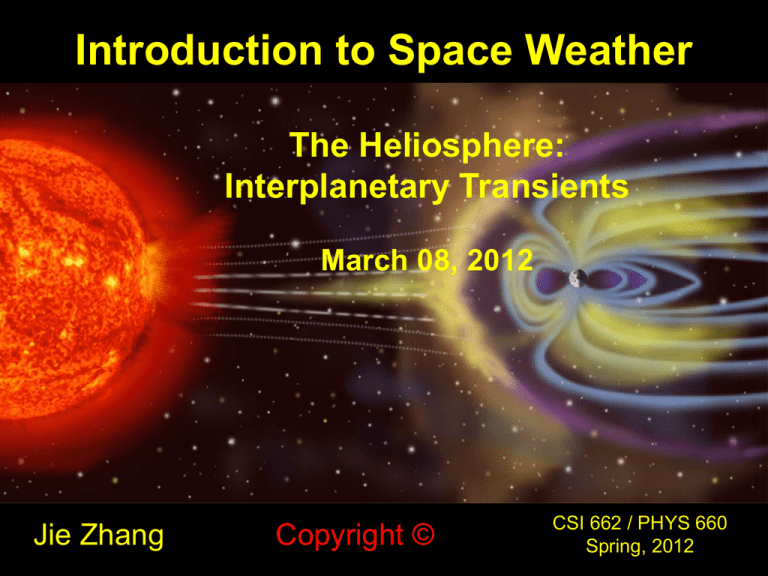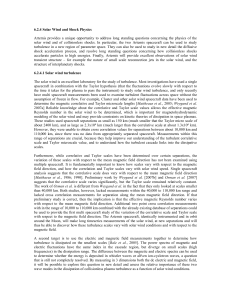Interplanetary Transients
advertisement

Introduction to Space Weather The Heliosphere: Interplanetary Transients March 08, 2012 Jie Zhang Copyright © CSI 662 / PHYS 660 Spring, 2012 Roadmap •Part 1: Sun •Part 2: Heliosphere •Part 3: Magnetosphere •Part 4: Ionosphere •Part 5: Space Weather Effects CH5: The Solar Wind CH6: Interplanetary Transients CSI 662 / PHYS 660 Mar. 08, 2012 CH6: Interplanetary Transients 6.1. Corotating Interaction Regions 6.2. Interplanetary Coronal Mass Ejections 6.3. Shock Waves 6.4. Solar Energetic Particles Plasma-10: Shock Wave Models CH6: Interplanetary Transients References and Reading Assignment: •KAL CH 6.3.4 (on CIRs) •KAL CH 6.7.7 (on ICMEs) •KAL CH 6.7.8 (on Interplanetary Shocks) •KAL CH 6.8 (on Shock Theory) Introduction • The magnetic field of background solar wind generally follows the Archimedean spiral, characterized by the large scale sector magnetic structures and heliospheric current sheet • They are usually steady and thus “quiet”; do not cause space weather disturbances • Space weather is caused by solar wind transients, or highly disturbed solar wind. • Solar wind transients are in two forms • Corotating interaction region (CIR) • Interplanetary CME (ICMEs) • Solar wind transients are responsible for geomagnetic storms 1. Increased IMF strength 2. Increased solar wind speed 3. Most importantly, the presence of southward IMF (Bz) CH 6.1. CIR •When a low latitude coronal hole appears (across the heliographic equator), fast wind exists in the ecliptic plane. The magnetic field of the fast wind is less curved than that of the slow wind •The fast stream “catches up” with the slow stream, compressing the preceding stream and producing a high pressure region. •This interaction region is at the leading edge of the fast stream, commonly called “corotating interaction region” or CIR •Since low-latitude coronal holes can live over several solar rotations, this structure can recur several times. CH 6.1. CIR CH 6.2. Interplanetary CME (ICME) •A CME propagates into the interplanetary space, plowing through the ambient solar wind •The magnetic structure of an ICME at 1 AU is similar to that in its solar origin, which is a highly helical flux rope. •At 1 AU, it is also called magnetic cloud •highly organized magnetic field is observed, e.g., smooth rotation •Large scale, crossing the Earth for ~ 24 hours Magnetic Cloud CH 6.2. ICME •A Fast ICME pushes through the interplanetary plasma, and produces a shock wave ahead of it. •A CME driven shock is efficient in accelerating energy particles •In addition to geomagnetic storms, CMEs are also responsible for energetic particle storms. ICME driven shock SW Observations •Direct solar wind observations are routine now •ACE (Advanced Composition Explorer) (1997-present) spacecraft at Lagrangian point 1 •WIND (1994-present) spacecraft (complicated orbit, sampling different parts of space) •Measuring •Magnetic field (3-D) •Plasma velocity (3-D), density, temperature •Particle energy, abundance, charge state, composition Example In Situ Observations of the 2008 Feb. 4 CME Credit: Brian Woods 12 CH 6.3. Shock Waves A Shock is a discontinuity separating two different regimes in otherwise continuous medium. • It is associated with a disturbance moving faster than the signal speed in the medium (in a gas the signal speed is the speed of sounds; in space plasma: Alfven speed) • At the shock front the properties of the medium change abruptly. – In a hydrodynamic shock, temperature and density increase – In a magnetohydrodynamic shock, magnetic field strength also increases. Example of IP Shock Shock Wave Theory Kallenrode: Chap 6.8 •Rankine-Hugoniot Equations: •Relate parameters between upstream and downstream •M: Mach number (shock speed/signal speed) CH 6.4. Solar Energetic Particles (SEP) •SEP with energies ranging from a few Kev to several Gev •Because traveling close to the speed of light, they reach the Earth in tens of minutes of the eruption •Small SEPs are caused by flare related acceleration •Large SEPs from CMEdriven shocks Time-variation of SEP fluxes CH 6.4. SEP •Large SEPs are accelerated by CME-driven IP shocks. •They can last for several days because of the continuing driving of the shock •Particle energy is gained from the kinetic energy of the shock front. •Refer to Kallenrode Chap 7 for details, if you are interested. The End




![Electrical Safety[]](http://s2.studylib.net/store/data/005402709_1-78da758a33a77d446a45dc5dd76faacd-300x300.png)




